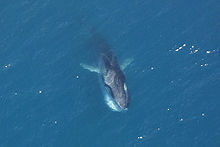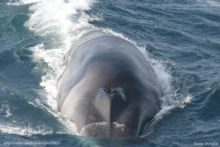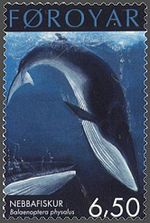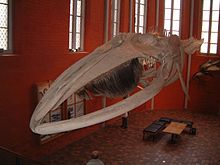- Fin whale
-
"Finback" redirects here. For the U.S. submarines of this name, see USS Finback. For the fictional character, see Finback (Transformers).
Fin whale[1] 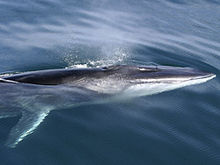
A fin whale surfaces in the Kenai Fjords, Alaska 
Size compared to an average human Conservation status Scientific classification Kingdom: Animalia Phylum: Chordata Class: Mammalia Subclass: Eutheria Order: Cetacea Suborder: Mysticeti Family: Balaenopteridae Genus: Balaenoptera Species: B. physalus Binomial name Balaenoptera physalus
(Linnaeus, 1758)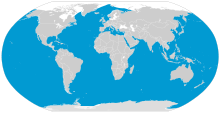
Fin whale range The fin whale (Balaenoptera physalus), also called the finback whale, razorback, or common rorqual, is a marine mammal belonging to the suborder of baleen whales. It is the second largest living animal after the blue whale,[3] growing to nearly 27 metres (88 ft) long.[3] The American naturalist Roy Chapman Andrews called the fin whale "the greyhound of the sea" because of its great speed when chased and slender build.[4]
Long and slender, the fin whale's body is brownish-grey with a paler underside. There are at least two distinct subspecies: the Northern fin whale of the North Atlantic, and the larger Antarctic fin whale of the Southern Ocean. It is found in all the world's major oceans, from polar to tropical waters. It is absent only from waters close to the ice pack at both the north and south poles and relatively small areas of water away from the open ocean. The highest population density occurs in temperate and cool waters.[5] Its food consists of small schooling fish, squid, and crustaceans including mysids and krill.
Like all other large whales, the fin whale was heavily hunted during the twentieth century and is an endangered species. Almost 750,000 fin whales were taken from the Southern Hemisphere alone between 1904 and 1979[6] and less than 15,000 currently remain in that region.[7] The International Whaling Commission (IWC) has issued a moratorium on commercial hunting of this whale,[8] although Iceland and Japan have resumed hunting: in 2009, Iceland took 125 fin whales during its whaling season, and Japan took 1 fin whale in its 2008-2009 Antarctic season.[9][10] The species is also hunted by Greenlanders under the Aboriginal Subsistence Whaling provisions of the IWC. Estimates suggest that the population of the remaining fin whales in the world's seas range from less than 100,000 to roughly 119,000.[2][11] Collisions with ships and noise from human activity also significantly threaten recovery.
Contents
Taxonomy
The fin whale has long been known to taxonomists. It was first described by Frederick Martens in 1675 and then again by Paul Dudley in 1725. These descriptions were used as the basis of the species Balaena physalus by Carl Linnaeus in 1758.[12] The Comte de Lacepede reclassified the species as Balaenoptera physalus early in the nineteenth century. The word "physalus" comes from the Greek word physa, meaning "blows".
Fin whales are rorquals, members of the family Balaenopteridae family, which also includes the humpback whale, the blue whale, the Bryde's whale, the sei whale and the minke whale. The family diverged from the other baleen whales in the suborder Mysticeti as long ago as the middle Miocene,[13] although it is not known when the members of these families further evolved into their own species. Hybridization between the blue whale and the fin whale is known to occur at least occasionally in the North Atlantic[14] and in the North Pacific.[15] Recent DNA evidence indicates that the fin whale may be more closely related to the humpback whale (Megaptera novaeangliae), and in at least one study the gray whale (Eschrichtius robustus), two whales in different genera, than it is to members of its own genus, such as the minke whales.[16][17] If further research confirms this theory, this taxonomy would need revision.
As of 2006, there are two named subspecies, each with distinct physical features and vocalizations. The Northern fin whale, B. p. physalus (Linnaeus 1758), inhabits the North Atlantic, and the Antarctic fin whale, B. p. quoyi (Fischer 1829), occupies the Southern Ocean.[18] Most experts consider the fin whales of the North Pacific to be a third, as yet unnamed species.[5] The three groups mix at most rarely.
Description and behavior
The fin whale is usually distinguished by its great length and slender build. The average size of males and females is 19 and 20 metres (62 and 66 ft), respectively. Subspecies in the Northern Hemisphere are known to reach lengths of up to 24 metres (79 ft) and the Antarctic subspecies reaches lengths of up to 26.8 metres (88 ft).[3] A full-sized adult has never been weighed, but calculations suggest that a 25 metres (82 ft) animal could weigh as much as 70,000 kilograms (150,000 lb). Full physical maturity is attained between 25 and 30 years. Fin whales live to 94 years of age,[19] although specimens have been found aged at an estimated 135–140 years.[20] A newborn fin whale measures about 6.5 metres (21 ft) in length and weighs approximately 1,800 kilograms (4,000 lb).[21] The animal's large size aids in identification, and it is usually only confused with the blue whale, the sei whale, or, in warmer waters, Bryde's whale.
The fin whale has a brownish grey top and sides and a whitish underside. It has a pointed snout, paired blowholes, and a broad, flat rostrum. Two lighter-coloured chevrons begin midline behind the blowholes and slant down the sides toward the tail on a diagonal upward to the dorsal fin, sometimes recurving forward on the back.[3] It has a large white patch on the right side of the lower jaw, while the left side of the jaw is grey or black.[21] This type of asymmetry can be seen occasionally in minke whales, but the fin whale's asymmetry is universal and thus is unique among cetaceans and is one of the keys to making a full identification. It was hypothesized to have evolved because the whale swims on its right side when surface lunging and it often circles to the right while at the surface above a prey patch. However, the whales just as often circle to the left. There is no accepted hypothesis to explain the asymmetry.[22]
The whale has a series of 56–100 pleats or grooves along the bottom of the body that run from the tip of the chin to the navel that allow the throat area to expand greatly during feeding. It has a curved, prominent 60 centimetres (24 in) dorsal fin about three-quarters of the way along the back. Its flippers are small and tapered, and its tail is wide, pointed at the tip, and notched in the centre.[3]
When the whale surfaces, the dorsal fin is visible soon after the spout. The spout is vertical and narrow and can reach heights of 6 metres (20 ft).[21] The whale will blow one to several times on each visit to the surface, staying close to the surface for about one and a half minutes each time. The tail remains submerged during the surfacing sequence. It then dives to depths of up to 250 metres (820 ft) each dive lasting between 10 and 15 minutes. Fin whales have been known to leap completely out of the water.[21]
Life history
Mating occurs in temperate, low-latitude seas during the winter, followed by an eleven months to one year gestation period. A newborn weans from its mother at 6 or 7 months of age when it is 11 or 12 metres (39 ft) in length, and the calf follows the mother to the winter feeding ground. Females reproduce every 2 to 3 years, with as many as 6 fetuses being reported, but single births are far more common. Females reach sexual maturity at between 3 and 12 years of age.[21]
Feeding
The fin whale is a filter-feeder, feeding on small schooling fish, squid, and crustaceans including mysids and krill.[21] In the North Pacific, they feed on the krill species Euphausia pacifica, Thysanoessa inermis, T. longipes, T. spinifera, and Nyctiphanes simplex; large copepods (mainly Neocalanus cristatus); squid (Ommastrephes sloani pacificus); and schooling fish such as herring, Japanese sardine (Sardinella melanosticta), walleye pollock (Theragra chalcogramma), capelin, and anchovies (Engraulis mordax). In the North Atlantic, they prey on krill (Meganyctiphanes norvegica and T. inermis) and small schooling fish (e.g. capelin, Mallotus villosus; herring, Clupea harengus; and sand lance, Ammodytes spp.). In the Southern Ocean they mainly consume E. superba.[5][23][24]
It feeds by opening its jaws while swimming at a relatively high speed, 11 kilometres per hour (6.8 mph) in one study,[25] which causes it to engulf up to 70 cubic metres (18,000 US gal; 15,000 imp gal) of water in one gulp. It then closes its jaws and pushes the water back out of its mouth through its baleen, which allows the water to leave while trapping the prey. An adult has between 262 and 473 baleen plates on each side of the mouth. Each plate is made of keratin that frays out into fine hairs on the ends inside the mouth near the tongue. Each plate can measure up to 76 centimetres (30 in) in length and 30 centimetres (12 in) in width.[3] The whale routinely dives to depths of more than 200 metres (660 ft) where it executes an average of four "lunges", where it feeds on aggregations of krill. Each gulp provides the whale with approximately 10 kilograms (22 lb) of krill.[25] One whale can consume up to 1,800 kilograms (4,000 lb) of food a day,[3] leading scientists to conclude that the whale spends about three hours a day feeding to meet its energy requirements, roughly the same as humans. If prey patches are not sufficiently dense, or are located too deep in the water, the whale has to spend a larger portion of its day searching for food.[25] One hunting technique is to circle schools of fish at high speed, frightening the fish into a tight ball, then turning on its side before engulfing the massed prey.[3]
Behavior
The fin whale is one of the fastest cetaceans and can sustain speeds of 37 kilometres per hour (23 mph)[21] and bursts in excess of 40 kilometres per hour (25 mph) have been recorded, earning the fin whale the nickname "the greyhound of the sea".[26] Fin whales are more gregarious than other rorquals, and often live in groups of 6–10, although feeding groups may reach up to 100 animals.[19]
Vocalizations
Multimedia relating to the fin whale
Note that the whale calls have been sped up 10x from their original speed.Like other whales, the male fin whale makes long, loud, low-frequency sounds.[21] The vocalizations of blue and fin whales are the lowest-frequency sounds made by any animal.[27] Most sounds are frequency-modulated (FM) down-swept infrasonic pulses from 16 to 40 hertz frequency (the range of sounds that most humans can hear falls between 20 hertz and 20 kilohertz). Each sound lasts one to two seconds, and various sound combinations occur in patterned sequences lasting 7 to 15 minutes each. The whale then repeats the sequences in bouts lasting up to many days.[28] The vocal sequences have source levels of up to 184–186 decibels relative to 1 micropascal at a reference distance of one metre, and can be detected hundreds of miles from their source.[29]
When fin whale sounds were first recorded by US biologists, they did not realize that these unusually loud, long, pure and regular sounds were being made by whales. They first investigated the possibilities that the sounds were due to equipment malfunction, geophysical phenomena, or even part of a Soviet Union scheme for detecting enemy submarines. Eventually, biologists demonstrated that the sounds were the vocalizations of fin whales.[27]
Direct association of these vocalizations with the reproductive season for the species and that only males make the sounds point to these vocalizations as possible reproductive displays.[30][31] Over the past 100 years, the dramatic increase in ocean noise from shipping and naval activity may have slowed the recovery of the fin whale population, by impeding communications between males and sexually receptive females.[32]
Range and habitat
Like many large rorquals, the fin whale is a cosmopolitan species. It is found in all the world's major oceans, and in waters ranging from the polar to the tropical. It is absent only from waters close to the ice pack at both the north and south extremities and relatively small areas of water away from the large oceans, such as the Red Sea, the Persian Gulf, the eastern part of the Mediterranean, and the Baltic Sea. The highest population density occurs in temperate and cool waters. It is less densely populated in the warmest, equatorial regions. It prefers deep waters beyond the continental shelf to shallow waters.
The North Atlantic fin whale has an extensive distribution, occurring from the Gulf of Mexico and Mediterranean Sea, northward to the edges of the Arctic ice pack. In general, fin whales are more common north of approximately 30°N latitude, but considerable confusion arises about their occurrence south of 30°N latitude because of the difficulty in distinguishing fin whales from Bryde's whales.[33] Extensive ship surveys have led researchers to conclude that the summer feeding range of fin whales in the western North Atlantic was mainly between 41°20'N and 51°00'N, from shore seaward to the 1,000 fathoms (1,800 m) contour.[34]
Summer distribution of fin whales in the North Pacific is the immediate offshore waters from central Baja California to Japan, and as far north as the Chukchi Sea bordering the Arctic Ocean.[35] They occur in high densities in the northern Gulf of Alaska and southeastern Bering Sea between May and October, with some movement through the Aleutian passes into and out of the Bering Sea.[36] Several whales tagged between November and January off southern California were killed in the summer off central California, Oregon, British Columbia, and in the Gulf of Alaska.[35] Fin whales have been observed feeding in Hawaiian waters in mid-May, and several winter sightings have been made there.[37] Some researchers have suggested that the whales migrate into Hawaiian waters primarily in the autumn and winter.[38]
Although fin whales are certainly migratory, moving seasonally in and out of high-latitude feeding areas, the overall migration pattern is not well understood. Acoustic readings from passive-listening hydrophone arrays indicate a southward migration of the North Atlantic fin whale occurs in the autumn from the Labrador-Newfoundland region, south past Bermuda, and into the West Indies.[39] One or more populations of fin whales are thought to remain year-round in high latitudes, moving offshore, but not southward in late autumn.[39] In the Pacific, migration patterns are poorly characterized. Although some fin whales are apparently present year-round in the Gulf of California, there is a significant increase in their numbers in the winter and spring.[40] Antarctic fin whales migrate seasonally from relatively high-latitude Antarctic feeding grounds in the summer to low-latitude breeding and calving areas in the winter. The location of winter breeding areas is still unknown, since these whales tend to migrate in the open ocean.[5]
Population and trends
Poor understanding of migration patterns combined with contradictory population surveys makes estimating the historical and current population levels of the whale difficult and contentious. Due to a long history of hunting this whale, pre-exploitation population levels are difficult to determine.
North Atlantic
North Atlantic fin whales are defined by the International Whaling Commission to exist in one of seven discrete population zones: Nova Scotia-New England, Newfoundland-Labrador, western Greenland, eastern Greenland-Iceland, North Norway, West Norway-Faroe Islands, and Ireland-Spain-United Kingdom-Portugal. Results of mark-and-recapture surveys have indicated that some movement occurs across the boundaries of these population zones, suggesting that each zone is not entirely discrete and that some immigration and emigration does occur.[34] J. Sigurjónsson estimated in 1995 that total pre-exploitation population size in the entire North Atlantic ranged between 50,000 and 100,000 animals,[41] but his research is criticized for not providing supporting data and an explanation of his reasoning.[5] In 1977, D.E. Sergeant suggested a "primeval" aggregate total of 30,000 to 50,000 throughout the North Atlantic.[42] Of that number, about 8,000 to 9,000 would have resided in the Newfoundland and Nova Scotia areas, with whales summering in U.S. waters south of Nova Scotia presumably omitted.[5][43] J.M. Breiwick estimated that the "exploitable" (above the legal size limit of ft50) component of the Nova Scotia population was 1,500 to 1,600 animals in 1964, reduced to only about 325 in 1973.[44] Two aerial surveys in Canadian waters since the early 1970s gave numbers of 79 to 926 whales on the eastern Newfoundland-Labrador shelf in August 1980,[45] and a few hundred in the northern and central Gulf of Saint Lawrence in August 1995–1996.[46] Summer estimates in the waters off western Greenland range between 500 and 2,000,[47] and in 1974, Jonsgard considered the fin whales off Western Norway and the Faroe Islands to "have been considerably depleted in postwar years, probably by overexploitation".[48] The population around Iceland appears to have fared much better, and in 1981, the population appeared to have undergone only a minor decline since the early 1960s.[49] Surveys during the summers of 1987 and 1989 estimated of 10,000 to 11,000 between eastern Greenland and Norway.[50] This shows a substantial recovery when compared to a survey in 1976 showing an estimate of 6,900, which was considered to be a "slight" decline since 1948.[51] A Spanish NASS survey in 1989 of the France-Portugal-Spain sub-area estimated a summer population range at 17,355.[52] The aggregate population level is estimated to be between 40,000[53] and 56,000[14] individuals.
North Pacific
The total historical North Pacific population was estimated at 42,000 to 45,000 before the start of whaling. Of this, the population in the eastern portion of the North Pacific was estimated to be 25,000 to 27,000.[54] By 1975, the estimate had declined to between 8,000 and 16,000.[55][56] Surveys conducted in 1991, 1993, 1996, and 2001 produced estimates of between 1,600 and 3,200 off California and 280 to 380 off Oregon and Washington.[57] The miniumum estimate for the California-Oregon-Washington population, as defined in the U.S. Pacific Marine Mammal Stock Assessments: 2005, is about 2,500.[58] Surveys in coastal waters of British Columbia in summers 2004 and 2005 produced abundance estimates of approximately 500 animals (95% confidence intervals: 201-1,220).[59] Surveys near the Pribilof Islands in the Bering Sea indicated a substantial increase in the local abundance of Fin Whales between 1975–1978 and 1987–1989.[60] In 1984, the entire population was estimated to be at less than 38% of its historic carrying capacity.[61]
Antarctica
Relatively little is known about the historical and current population levels of the Antarctic fin whale. The IWC officially estimates that the Southern Hemisphere pre-whaling population was 400,000 whales, and that the population in 1979 (at the cessation of Antarctic large scale whaling) was 85,200.[62] Both the current and historical estimates should be considered as poor estimates because the methodology and data used in the study are known to be flawed.[5] Other estimates cite current size to be between 15,000 (1983) and 38,000 (1997).[2] As of 2006, there is no scientifically accepted estimate of current population or trends in abundance.[5]
Human interaction
In the 19th century, the fin whale was occasionally hunted by open-boat whalers, but it was relatively safe because of its speed and the fact that it often sank when killed. However, the later introduction of steam-powered boats and harpoons that exploded on impact made it possible to kill and secure them along with blue whales and sei whales on an industrial scale. As other whale species became over-hunted, the whaling industry turned to the still-abundant fin whale as a substitute.[63] It was primarily hunted for its blubber, oil, and baleen. Approximately 704,000 fin whales were caught in Antarctic whaling operations alone between 1904 and 1975.[64]
The introduction of factory ships with stern slipways in 1925 substantially increased the number of whales taken per year. In 1937 alone, over 28,000 fin whales were taken. From 1953 to 1961, the catch averaged around 25,000 per year. By 1962, sei whale catches began to increase as fin whales became scarce. By 1974, fewer than 1,000 fin whales were being caught each year. In the North Pacific, a reported total of approximately 46,000 fin whales were killed by commercial whalers between 1947 and 1987.[65]
The IWC prohibited hunting in the southern hemisphere in 1976.[64] The Soviet Union engaged in the illegal killing of protected whale species in the North Pacific, rendering reported catch data incomplete.[66] The fin whale was given full protection from commercial whaling by the IWC in the North Pacific in 1976, and in the North Atlantic in 1987, with small exceptions for aboriginal catches and catches for research purposes.[21] All populations worldwide remain listed as endangered species by the US National Marine Fisheries Service and the International Conservation Union Red List, and the fin whale is on Appendix 1 of CITES.[2][21][67][68]
The IWC has set a quota of 19 fin whales per year for Greenland. Meat and other products from whales killed in these hunts are widely marketed within Greenland, but export is illegal. Iceland and Norway are not bound by the IWC's moratorium on commercial whaling because both countries filed objections to the moratorium.[5] In October 2006, Iceland's fisheries ministry authorized the hunting of nine fin whales through August 2007.[69]
In the southern hemisphere, Japan permits annual takes of 10 fin whales under its Antarctic Special Permit whaling program for the 2005–2006 and 2006–2007 seasons.[70] The proposal for 2007–2008 and the subsequent 12 seasons allows taking 50 per year,[5] but by the close of the 2007-2008 season in April 2008, no fin whales had been caught.[71]
Collisions with ships are a major cause of mortality. In some areas, they cause a substantial portion of large whale strandings. Most serious injuries are caused by large, fast-moving ships over or near the continental shelf.[72]
Conservation
The Fin whale is listed on both Appendix I[73] and Appendix II[73] of the Convention on the Conservation of Migratory Species of Wild Animals (CMS). It is listed on Appendix I[73] as this species has been categorized as being in danger of extinction throughout all or a significant proportion of their range and CMS Parties strive towards strictly protecting these animals, conserving or restoring the places where they live, mitigating obstacles to migration and controlling other factors that might endanger them and also on Appendix II[73] as it has an unfavourable conservation status or would benefit significantly from international co-operation organised by tailored agreements. In addition, Fin whale is covered by the Agreement on the Conservation of Cetaceans in the Black Sea, Mediterranean Sea and Contiguous Atlantic Area (ACCOBAMS) and the Memorandum of Understanding for the Conservation of Cetaceans and Their Habitats in the Pacific Islands Region (Pacific Cetaceans MOU).
See also
- Ghen v. Rich
- Whaling in Iceland
- 100-tonne fin whale washed up on Cornish beach may have been killed by ship. The Times 23 February 2010 p. 16
References
- ^ Mead, James G.; Brownell, Robert L., Jr. (16 November 2005). "Order Cetacea (pp. 723-743)". In Wilson, Don E., and Reeder, DeeAnn M., eds. Mammal Species of the World: A Taxonomic and Geographic Reference (3rd ed.). Baltimore: Johns Hopkins University Press, 2 vols. (2142 pp.). p. 725. ISBN 978-0-8018-8221-0. OCLC 62265494. http://www.bucknell.edu/msw3/browse.asp?id=14300023.
- ^ a b c d Reilly, S.B., Bannister, J.L., Best, P.B., Brown, M., Brownell Jr., R.L., Butterworth, D.S., Clapham, P.J., Cooke, J., Donovan, G.P., Urbán, J. & Zerbini, A.N. (2008). Balaenoptera physalus. In: IUCN 2008. IUCN Red List of Threatened Species. Downloaded on 7 October 2008.
- ^ a b c d e f g h "Balaenoptera physalus Fin Whale". MarineBio.org. http://marinebio.org/species.asp?id=40. Retrieved 2006-10-23.
- ^ Andrews, Roy Chapman. 1916. Whale hunting with gun and camera; a naturalist's account of the modern shore-whaling industry, of whales and their habits, and of hunting experiences in various parts of the world. New York: D. Appleton and Co., p. 158.
- ^ a b c d e f g h i j National Marine Fisheries Service (2006) (pdf). Draft recovery plan for the fin whale (Balaenoptera physalus). Silver Spring, Maryland: National Marine Fisheries Service. http://www.nmfs.noaa.gov/pr/pdfs/recovery/draft_finwhale.pdf.
- ^ http://www.edgeofexistence.org/mammals/species_info.php?id=89
- ^ http://gdl.cdlr.strath.ac.uk/scotia/gooant/gooant070204.htm
- ^ "Revised Management Scheme". International Whaling Commission. http://www.iwcoffice.org/conservation/rms.htm. Retrieved 2006-11-07.
- ^ Revkin, Andrew C. (2009-09-08). "Iceland Defends Its Hunt of 94 (Now 125) Fin Whales". The New York Times. http://dotearth.blogs.nytimes.com/2009/09/08/us-rebukes-iceland-for-killing-94-fin-whales.
- ^ http://www.iwcoffice.org/conservation/table_permit.htm
- ^ Shirihai, H. and Jarrett, B. (2006). Whales, Dolphins and Other Marine Mammals of the World. Princeton Field Guides. p. 43–45. ISBN 0-61-12757-2.
- ^ (Latin) Linnaeus, C (1758). Systema naturae per regna tria naturae, secundum classes, ordines, genera, species, cum characteribus, differentiis, synonymis, locis. Tomus I. Editio decima, reformata.. Holmiae. (Laurentii Salvii).. pp. 824. http://dz1.gdz-cms.de/index.php?id=img&no_cache=1&IDDOC=265100.
- ^ Gingerich, P. (2004). "Whale Evolution". McGraw-Hill Yearbook of Science & Technology. The McGraw Hill Companies. ISBN 0-07-142784-8.
- ^ a b Bérubé, M.; A. Aguilar (1998). "A new hybrid between a blue whale, Balaenoptera musculus, and a fin whale, B. physalus: frequency and implications of hybridization". Mar. Mamm. Sci. 14: 82–98. doi:10.1111/j.1748-7692.1998.tb00692.x. http://www.blackwell-synergy.com/doi/abs/10.1111/j.1748-7692.1998.tb00692.x?cookieSet=1&journalCode=mms.
- ^ Doroshenko, V.N. (1970). "A whale with features of the fin and blue whale (in Russian)". Izvestia TINRO 70: 225–257.
- ^ Arnason, U., Gullberg A. & Widegren, B. (1 September 1993). "Cetacean mitochondrial DNA control region: sequences of all extant baleen whales and two sperm whale species". Molecular Biology and Evolution 10 (5): 960–970. PMID 8412655. http://mbe.oxfordjournals.org/cgi/content/abstract/10/5/960. Retrieved 2009-01-25.
- ^ Sasaki, T. et al. (February 23, 2005). "Mitochondrial Phylogenetics and Evolution of Mysticete Whales". Systematic Biology 54 (1): 77–90. doi:10.1080/10635150590905939. PMID 15805012. http://sysbio.oxfordjournals.org/content/54/1/77.full. Retrieved 2009-01-25.
- ^ "Balaenoptera physalus". Integrated Taxonomic Information System. http://www.itis.gov/servlet/SingleRpt/SingleRpt?search_topic=TSN&search_value=180527. Retrieved 23 October 2006.
- ^ a b Martin, Anthony R. (1991). Whales and dolphins. London: Salamander Books. ISBN 0-8160-3922-4.
- ^ Danmarks Radio, 2010-10-28.
- ^ a b c d e f g h i j Fox, David (2001). "Balaenoptera physalus (fin whale)". Animal Diversity Web. http://animaldiversity.ummz.umich.edu/site/accounts/information/Balaenoptera_physalus.html. Retrieved 2006-10-22.
- ^ Tershy, B. R.; D. Wiley (1992). "Asymmetrical pigmentation in the fin whale: a test of two feeding related hypotheses". Marine Mammal Science 8 (3): 315–318. doi:10.1111/j.1748-7692.1992.tb00416.x.
- ^ Reynolds, John Elliott, and Sentiel A. Rommel. 1999. Biology of Marine Mammals. Washington: Smithsonian Institution Press.
- ^ S.L. Perry; D.P. DeMaster, and G.K. Silber (1999). "Special Issue: The Great Whales: History and Status of Six Species Listed as Endangered Under the U.S. Endangered Species Act of 1973". Marine Fisheries Review 61 (1): 52–58. http://spo.nwr.noaa.gov/mfr611/mfr611.htm.
- ^ a b c Lin, Brian (2007-06-07). "Whale Has Super-sized Big Gulp". University of British Columbia. http://www.publicaffairs.ubc.ca/ubcreports/2007/07jun07/whale.html. Retrieved 2007-06-08.
- ^ "Fin Whale". nature.ca: Canadian Museum of Nature. http://www.nature.ca/notebooks/english/finwale.htm. Retrieved 2006-10-22.
- ^ a b Payne, Roger (1995). Among Whales. New York: Scribner. pp. 176. ISBN 0-684-80210-4.
- ^ "Finback Whales". Bioacoustics Research Program, Cornell Lab of Ornithology. http://www.birds.cornell.edu/brp/listen-to-project-sounds/fin-whales. Retrieved 2006-10-26.
- ^ W. J. Richardson, C. R. Greene, C. I. Malme and D. H. Thomson, Marine Mammals and Noise (Academic Press, San Diego, 1995).
- ^ Croll, D.A.; Clark, C.W., Acevedo, A., Flores, S., Gedamke, J., and Urban, J. (2002). "Only male fin whales sing loud songs" (pdf). Nature 417 (6891): 809. doi:10.1038/417809a. http://polymer.bu.edu/hes/articles/aabmsss02.pdf.
- ^ Watkins, W.; Tyack, P., Moore, K., Bird, J. (1987). "The 20 Hz signals of finback whales (Balaenoptera physalus)". The Journal of the Acoustical Society of America 82 (6): 1901–1902. doi:10.1121/1.395685. http://scitation.aip.org/getabs/servlet/GetabsServlet?prog=normal&id=JASMAN000082000006001901000001&idtype=cvips&gifs=yes.
- ^ Segelken, R. (2002-06-19). "Humanity's din in the oceans could be blocking whales' courtship songs and population recovery". Cornell University. http://www.news.cornell.edu/releases/June02/ocean_noise.hrs.html. Retrieved 2006-11-11.
- ^ Mead, J.G. (1977). "Records of Sei and Bryde's whales from the Atlantic Coast of the United States, the Gulf of Mexico, and the Caribbean". Rep. Int. Whal. Commn Spec. Iss. 1: 113–116. ISBN 0-906975-03-4.
- ^ a b Mitchell, E. (1974). "Present status of Northwest Atlantic fin and other whale stocks". In W.E. Schevill (ed.). The Whale Problem: A Status Report. Cambridge, MA: Harvard University Press. pp. 108–169. ISBN 0-674-95075-5.
- ^ a b Rice, D.W. (1974). "Whales and whale research in the eastern North Pacific". In W.E. Schevill (ed.). The Whale Problem: A Status Report. Cambridge, MA: Harvard University Press. pp. 170–195. ISBN 0-674-95075-5.
- ^ Reeves, R.R.; M.W. Brown (1985). "Whaling in the Bay of Fundy". Whalewatcher 19 (4): 14–18.
- ^ Mobley, J.R., Jr.; M. Smultea, T. Norris and D. Weller (1996). "Fin whale sighting north of Kaua'i, Hawai'i". Pacific Science 50 (2): 230–233.
- ^ Thompson, P.O.; W.A. Friedl (1982). "A long term study of low frequency sound from several species of whales off Oahu, Hawaii". Cetology 45: 1–19.
- ^ a b Clark, C.W. (1995). "Application of US Navy underwater hydrophone arrays for scientific research on whales". Rep. Int. Whal. Commn 45: 210–212.
- ^ Tershy, B.R.; D. Breese and C.S. Strong (1990). "Abundance, seasonal distribution and population composition of balaenopterid whales in the Canal de Ballenas, Gulf of California, Mexico". Rep. Int. Whal. Commn Spec. Iss. 12: 369–375. ISBN 0-906975-23-9.
- ^ Sigurjónsson, J. (1995). "On the life history and autecology of North Atlantic rorquals". In A.S. Blix, L. Walløe, and Ø. Ulltang (ed.). Whales, Seals, Fish and Man. Elsevier Science. pp. 425–441. ISBN 0-444-82070-1.
- ^ D.E. Sergeant (1977). "Stocks of fin whales Balaenoptera physalus L. in the North Atlantic Ocean". Rep. Int. Whal. Commn 27: 460–473.
- ^ Allen, K.R. (1970). "A note on baleen whale stocks of the north west Atlantic". Rep. Int. Whal. Commn 20: 112–113.
- ^ Breiwick, J.M. (1993). Population dymanics and analyses of the fisheries for fin whales (Balaenoptera physalus) in the northwest Atlantic Ocean. (Ph.D. thesis) University of Washington, Seattle. 310 pp..
- ^ Hay, K. (1982). "Aerial line-transect estimates of abundance of humpback, fin, and long-finned pilot whales in the Newfoundland-Labrador area". Rep. Int. Whal. Commn 31: 373–387.
- ^ Kingsley, M.C.S.; R.R. Reeves (1998). "Aerial surveys of cetaceans in the Gulf of St. Lawrence in 1995 and 1996". Marine Mammal Science 17 (1): 35–75. doi:10.1139/cjz-76-8-1529. http://rparticle.web-p.cisti.nrc.ca/rparticle/AbstractTemplateServlet?journal=cjz&volume=76&year=&issue=&msno=z98-054&calyLang=eng.
- ^ Larsen, F. (1995). "Abundance of minke and fin whales off West Greenland". Rep. Int. Whal. Commn 45: 365–370.
- ^ Jonsgard, A. (1974). "On whale exploitation in the eastern part of the North Atlantic Ocean". In W.E. Schevill (ed.). The Whale Problem: A Status Report. Cambridge, MA: Harvard University Press. pp. 97–107. ISBN 0-674-95075-5.
- ^ Rørvik, C.J.; J. Sigurjónsson (1981). "A note on the catch per unit effort in the Icelandic fin whale fishery". Rep. Int. Whal. Commn 31: 379–383.
- ^ Buckland, S.T.; K.L. Cattanach and Th. Gunnlaugsson (1992). "Fin whale abundance in the North Atlantic, estimated from Icelandic and Faroese NASS-87 and NASS-89 data". Rep. Int. Whal. Commn 42: 645–651.
- ^ Rørvik, C.J.; J. Jónsson, O.A. Mathisen, and Å. Jonsgård (1976). "Fin Whales, Balaenoptera physalus (L.), Off the West Coast of Iceland. Distribution, Segregation by Length and Exploitation". Rit Fiskideildar 5: 1–30. ISSN 0484-9019.
- ^ Buckland, S.T.; K.L. Cattanach and S. Lens (1992). "Fin whale abundance in the eastern North Atlantic, estimated from Spanish NASS-89 data". Rep. Int. Whal. Commn 42: 457–460.
- ^ Bérubé, M.; Aguilar, A., Dendanto, D., Larsen, F., Notarbartolo di Sciara, G., Sears, R., Sigurjónsson, J., Urbán-R, J. and Palsbøll, P.J. (1998). "Population genetic structure of North Atlantic, Mediterranean Sea and Sea of Cortez Fin Whales, Balaenoptera physalus (Linnaeus 1758): analysis of mitochondrial and nuclear foci". Molecular Ecology 7 (5): 585–599. doi:10.1046/j.1365-294x.1998.00359.x. ISSN 1471-8278. PMID 9633102. http://www.ingentaconnect.com/content/bsc/mecol/1998/00000007/00000005/art00004.
- ^ Ohsumi, S.; S. Wada (1974). "Status of whale stocks in the North Pacific, 1972". Rep. Int. Whal. Commn 24: 114–126.
- ^ Rice, D.W. (1974). "Whales and whale research in the eastern North Pacific". In W.E. Schevill (ed.). The Whale Problem: A Status Report. Cambridge, MA: Harvard University Press. pp. 170–195. ISBN 0-674-95075-5.
- ^ Chapman, D.G. (1976). "Estimates of stocks (original, current, MSY level and MSY)(in thousands) as revised at Scientific Committee meeting 1975". Rep. Int. Whal. Commn 26: 44–47.
- ^ Barlow, J. (2003). Preliminary estimates of the Abundance of Cetaceans along the U.S. West Coast: 1991–2001. Administrative report LJ-03-03, available from Southwest Fisheries Science Center, 8604 La Jolla Shores Dr., La Jolla CA 92037.
- ^ Caretta, J.V., K.A. Forney, M.M. Muto, J. Barlow, J. Baker, B. Hanson, and M.S. Lowry (2006) (PDF). U.S. Pacific Marine Mammal Stock Assessments: 2005. U.S. Department of Commerce Technical Memorandum, NOAA-TM-NMFS-SWFSC-388. http://www.nmfs.noaa.gov/pr/pdfs/sars/po2005.pdf.
- ^ Williams, R. and Thomas, L. (2007). "Distribution and abundance of marine mammals in the coastal waters of BC, Canada" (PDF). Journal of Cetacean Research and Management 9: 15–28. http://www.marinemammal.org/MMRU/williams/williams%20thomas%20jcrm%202007%20015-028.pdf.
- ^ Baretta, L.; G.L. Hunt, Jr. (1994). "Changes in the numbers of cetaceans near the Pribilof Islands, Bering Sea, between 1975–78 and 1987–89" (PDF). Arctic 47: 321–326. http://pubs.aina.ucalgary.ca/arctic/Arctic47-4-321.pdf.
- ^ Mizroch, S.A.; D.W. Rice, and J.M. Breiwick (1984). "The fin whale, Balaenoptera physalus". Mar. Fish. Review 46: 20–24.
- ^ IWC (1979). "Report of the sub-committee on protected species. Annex G, Appendix I". Rep. Int. Whal. Commn 29: 84–86.
- ^ "American Cetacean Society Fact Sheet: Fin Whale, Balaenoptera physalus". American Cetacean Society. http://www.acsonline.org/factpack/finwhl.htm. Retrieved 2006-10-23.
- ^ a b IWC (1995). "Report of the scientific committee". Rep. Int. Whal. Commn 45: 53–221.
- ^ Barlow, J., K. A. Forney, P.S. Hill, R.L. Brownell, Jr., J.V. Caretta, D.P. DeMaster, F. Julian, M.S. Lowry, T. Ragen, and R.R. Reeves (1997) (PDF). U.S. Pacific Marine Mammal Stock Assessments: 1996. NOAA Technical Memo NMFD-SWFSC-248. http://swfsc.noaa.gov/publications/TM/SWFSC/NOAA-TM-NMFS-SWFSC-248.PDF.
- ^ Yablokov, A.V. (1994). "Validity of whaling data". Nature 367 (6459): 108. doi:10.1038/367108a0.
- ^ "UNEP-WCMC Species Database: CITES-Listed Species". UNEP-WCMC. 2006-10-23. http://www.unep-wcmc.org/isdb/CITES/Taxonomy/tax-species-result.cfm?displaylanguage=eng&Genus=Balaenoptera&Species=physalus&source=animals&Country=&tabname=status. Retrieved 2006-10-23.
- ^ "Species Profile for Finback whale". U.S. Fish & Wildlife Service. http://ecos.fws.gov/speciesProfile/SpeciesReport.do?spcode=A02O. Retrieved 2006-10-23.
- ^ "Iceland to Resume Whale Hunting, Defying Global Ban". Bloomberg.com. 2006-10-18. http://www.bloomberg.com/apps/news?pid=20601085&sid=a4fs59pxIqXI&refer=europe. Retrieved 2006-10-23.
- ^ "U.S. Protests Japan’s Announced Return to Whaling in Antarctic". Bureau of International Information Programs, U.S. Department of State. 20 November 2006. http://www.america.gov/st/washfile-english/2006/November/20061120171913lcnirellep0.9033319.html. Retrieved 2006-11-27.
- ^ "Less food for hungry migrants". The Dominion Post. 21 June 2008. http://www.stuff.co.nz/stuff/dominionpost/4590109a26386.html. Retrieved 2008-06-21.[dead link]
- ^ Laist, D.W.; Knowlton, A.R., Mead, J.G., Collet A.S., and Podesta, M. (2001). "Collisions between ships and whales" (PDF). Marine Mammal Science 17: 35–75. doi:10.1111/j.1748-7692.2001.tb00980.x. http://www.nero.noaa.gov/shipstrike/whatsnew/Laist%20et%20al_2001.pdf.
- ^ a b c d "Appendix I and Appendix II" of the Convention on the Conservation of Migratory Species of Wild Animals (CMS). As amended by the Conference of the Parties in 1985, 1988, 1991, 1994, 1997, 1999, 2002, 2005 and 2008. Effective: 5th March 2009.
General references
- Peter Saundry. 2011. Fin whale. Encyclopedia of Earth. National Council for Science and the Environment. Washington DC. C.Michael Hogan Ed. Content partner: Encyclopedia of Life
- National Audubon Society Guide to Marine Mammals of the World, Reeves, Stewart, Clapham and Powell, ISBN 0-375-41141-0
- Whales & Dolphins Guide to the Biology and Behaviour of Cetaceans, Maurizio Wurtz and Nadia Repetto. ISBN 1-84037-043-2
- Encyclopedia of Marine Mammals, editors Perrin, Wursig and Thewissen, ISBN 0-12-551340-2
External links
Listen to this article (info/dl)
This audio file was created from a revision of Fin whale dated 2008-01-01, and does not reflect subsequent edits to the article. (Audio help)More spoken articles- US National Marine Fisheries Service fin whale web page
- ARKive - images and movies of the fin whale (Balaenoptera physalus)
- Finback whale sounds
- IUCN Red List entry
- Photograph of a fin whale underwater
- Photographs of a fin whale breaching
- World Wide Fund for Nature (WWF) - species profile for the fin whale
- Official website of the Agreement on the Conservation of Cetaceans in the Black Sea, Mediterranean Sea and Contiguous Atlantic Area
Categories:- IUCN Red List endangered species
- Megafauna of Eurasia
- Megafauna of Africa
- Megafauna of Australia
- Baleen whales
- Mammals of Europe
- Mammals of Africa
- Fauna of the Indian Ocean
- Cetaceans of Australia
- EDGE Species
- Fauna of the Atlantic Ocean
- Fauna of the Pacific Ocean
- Animals described in 1758
Wikimedia Foundation. 2010.



